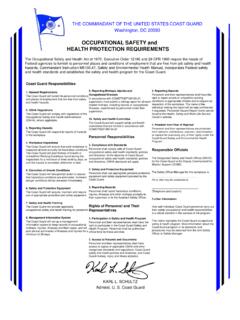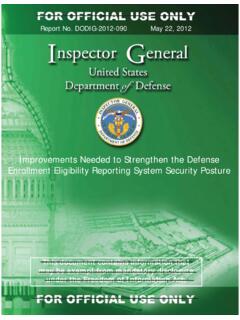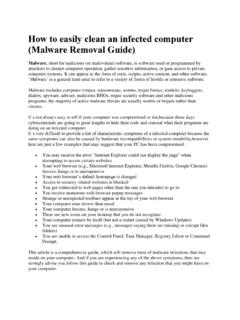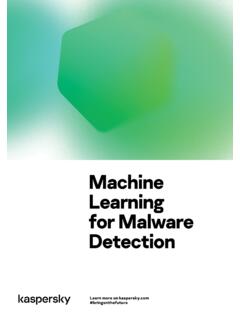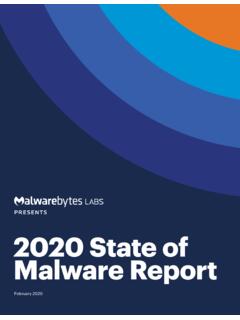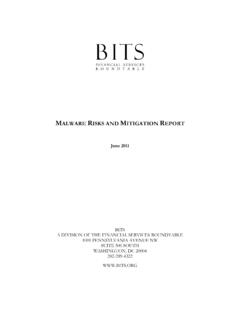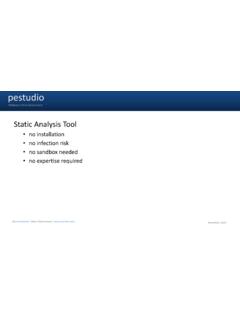Transcription of Detect and Prevent Web Shell Malware
1 U/OO/134094-20 PP-20-0901 21 APRIL 2020 Cybersecurity Information National Security Agency Detect and Prevent Web Shell Malware Summary Cyber actors have increased the use of web Shell Malware for computer network exploitation [1][2][3][4]. Web Shell Malware is software deployed by a hacker, usually on a victim s web server. It can be used to execute arbitrary system commands, which are commonly sent over HTTP or HTTPS. Web Shell attacks pose a serious risk to DoD components. Attackers often create web shells by adding or modifying a file in an existing web application. Web shells provide attackers with persistent access to a compromised network using communication channels disguised to blend in with legitimate traffic.
2 Web Shell Malware is a long-standing, pervasive threat that continues to evade many security tools. Cyber actors deploy web shells by exploiting web application vulnerabilities or uploading to otherwise compromised systems. Web shells can serve as persistent backdoors or as relay nodes to route attacker commands to other systems. Attackers frequently chain together web shells on multiple compromised systems to route traffic across networks, such as from internet-facing systems to internal networks [5] . It is a common misperception that only internet-facing systems are targeted for web shells. Attackers frequently deploy web shells on non-internet facing web servers, such as internal content management systems or network device management interfaces.
3 Internal web applications are often more susceptible to compromise due to lagging patch management or permissive security requirements. Though the term web shells is predominantly associated with Malware , it can also refer to web-based system management tools used legitimately by administrators. While not the focus of this guidance, these benign web shells may pose a danger to organizations as weaknesses in these tools can result in system compromise. Administrators should use system management software leveraging enterprise authentication methods, secure communication channels, and security hardening. Mitigating Actions (DETECTION) Web shells are difficult to Detect as they are easily modified by attackers and often employ encryption, encoding, and obfuscation.
4 A defense-in-depth approach using multiple detection capabilities is most likely to discover web Shell Malware . Detection methods for web shells may falsely flag benign files. When a potential web Shell is detected, administrators should validate the file s origin and authenticity. Detection techniques include: Known-Good Comparison Web shells primarily target existing web applications and rely on creating or modifying files. The best method of detecting these web shells is to compare a verified benign version of the web application ( , a known-good ) against the production version. Discrepancies should be manually reviewed for authenticity. Additional information and scripts to enable known-good comparison are available in Appendix A and are maintained on When adjudicating discrepancies with a known-good image, administrators are cautioned against trusting timestamps on suspicious systems.
5 Some attackers use a technique known as timestomping [6] to alter created and modified times in order to add legitimacy to web Shell files. Administrators should not assume that a modification is authentic simply because it appears to have occurred during a maintenance period. However, as an initial triage method, administrators may choose to prioritize verification of files with unusual timestamps. Web Traffic Anomaly Detection While attackers often design web shells to blend in with normal web traffic, some characteristics are difficult to imitate without advanced knowledge. These characteristics include user agent strings and client Internet Protocol (IP) address space.
6 Prior to having a presence on a network, attackers are unlikely to know which user agents or IP addresses are U/OO/134094-20 PP-20-0901 21 APRIL 2020 2 NSA & ASD: Detect and Prevent Web Shell Malware typical for a web server, so web Shell requests will appear anomalous. In addition, web shells routing attacker traffic will default to the web server s user agent and IP address, which should be unusual in network traffic. Uniform Resource Identifiers (URIs) exclusively accessed by anomalous user agents are potentially web shells. Finally, some attackers neglect to disguise web Shell request referer [sic] headers 1 as normal traffic. Consequently, requests with missing or unusual referer headers could indicate web Shell presence.
7 Centralized log-querying capabilities, such as Security Information and Event Management (SIEM) systems, provide a means to implement this analytic. If such a capability is not available, administrators may use scripting to parse web server logs to identify possible web Shell URIs. Example Splunk 2 queries (Appendix B), scripts for analyzing log data (Appendix C), and additional information about detecting web traffic anomalies are maintained at Signature-Based Detection From the host perspective, signature-based detection is unreliable because web shells may be obfuscated and are easy to modify. However, some cyber actors use popular web shells ( , China Chopper, WSO, C99, B374K, R57) with minimal modification.
8 In these cases, fingerprint or expression-based detection may be possible. A collection of Snort 3 rules to Detect common web Shell files, scanning instructions, and additional information about signature-based detection are maintained at From the network perspective, signature-based detection of web shells is unreliable because web Shell communications are frequently obfuscated or encrypted. Additionally, hard-coded values like variable names are easily modified to further evade detection. While unlikely to discover unknown web shells, signature-based network detection can help identify additional infections of a known web Shell . Appendix D provides a collection of signatures to Detect network communication from common, unmodified or slightly modified web shells sometimes deployed by attackers.
9 This list is also maintained at Unexpected Network Flows In some cases, attackers use web shells on systems other than web servers ( , workstations). These web shells operate on rogue web server applications and can evade file-based detection by running exclusively in memory ( , fileless execution). While functionally similar to a traditional Remote Access Tool (RAT), these types of web shells allow attackers to easily chain malicious traffic through a uniform platform. These types of web shells can be detected on well-managed networks because they listen and respond on previously unused ports. Additionally, if an attacker is using a perimeter web server to tunnel traffic into a network, connections would be made from a perimeter device to an internal node.
10 If administrators know which nodes on their network are acting as web servers, then network analysis can reveal these types of unexpected flows. A variety of tools including vulnerability scanners ( , Nessus 4), intrusion detection systems ( , Snort ), and network security monitors ( , Zeek 5 [formerly Bro ]) can reveal the presence of unauthorized web servers in a network. Maintaining a thorough and accurate depiction of expected network activity can enhance defenses against many types of attack. The Snort rule in Appendix E and maintained at can be tailored for a specific network to identify unexpected network flows. Endpoint Detection and Response (EDR) Capabilities Some EDR and enhanced host logging solutions may be able to Detect web shells based on system call or process lineage abnormalities.
